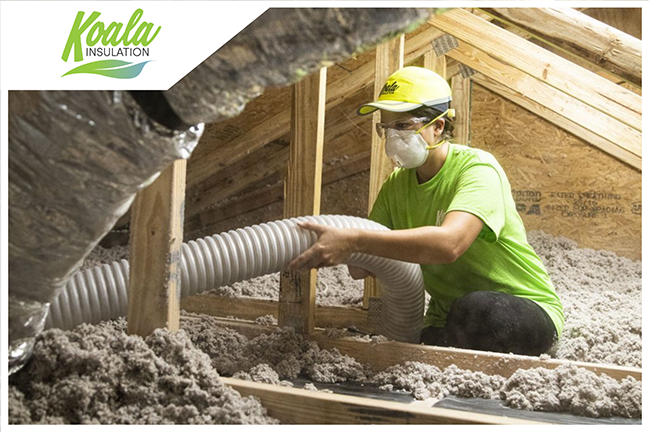What is “Blown-in” Insulation, and Why Should I Use it in My Home?

What is “Blown-in” Insulation, and Why Should I Use it in My Home?
Insulating a home can save money that would be spent on heating, help the environment, and give a home a nice, cozy atmosphere. There are many different types of insulation available to choose from however, and it can be quite intimidating to make a choice when the options aren’t well-understood.
This article will be covering blown-in insulation and when it would be suitable to use it.
What is blown-in insulation?
Blown-in insulation is a type of insulation that’s named for how it is applied. Where roll or batt insulation is measured to fit, then cut and laid strategically, blown-in insulation is sprayed into the space that needs to be insulated via compressed air.
Then, a special fabric will cover the installed insulation to create a seamless blanket that can cover and fill and voids, including electrical protrusions.
A common assumption about blown-in insulation is that its application process isn’t as precise as others, but it’s actually more precise. While it may seem like the insulation materials are being sprayed about haphazardly, a lot of science and care is involved.
What is blown-in insulation made of?
Blown-in insulation is made from cellulose and fiberglass.
The fibers in the cellulose come from cardboard, newspaper, or wood and can be made with or without binders. It’s also treated chemically with borate, which retards fire.
The cellulose has a higher R-value right after installation (a material’s R-value denotes its insulating effectiveness), but because it’s organic, it will decay slightly and ‘settle’ over time, so its R-value will diminish gradually.
The fiberglass is made from glass and other raw materials. These are melted then spun to form fibers that look a lot like wool. Fiberglass retains its insulating properties and R-value over time without deterioration, but is a lot more expensive to make and use than cellulose. That fact, combined with other unique properties of cellulose means that it’s best to use a mixture of both.
What are the benefits of blown-in insulation?
Blown-in insulation:
- Is energy efficient: it can protect a home from excessive heat as well as the cold. Compared to standard rolled batting insulation, blown-in insulation is more airtight and can cut heating and cooling costs by 30%.
- Cuts down noise: in the same way that blown-in insulation prevents heat from passing through it, it also dampens sound. This property can be very useful if the insulation is placed in a cavity.
- Is easy to install: when done correctly by a professional, blown-in insulation can be extremely quick to install (this also cuts down on installation costs).
- Covers comprehensively: some spaces have obstacles in them, such as plumbing pipes, crossbeams, wiring, ductwork, etc. Its nature and method of installation mean that blown-in insulation covers any space comprehensively and doesn’t leave gaps.
Additionally, the fiberglass in blown-in insulation makes it:
- Moisture-resistant: it acts as a vapor barrier, preventing mildew, mold, and bacteria from growing.
- Fire-resistant: the material is non-flammable and non-combustible.
- Lightweight: the strands of blown glass are lightweight and micron-thin.
- Eco-friendly: over half of the material is recycled, and the rest is made from sade.
And the cellulose is:
- Pest-resistant: the cellulose is treated with boric acid. This acts as a pesticide and repels fleas, termites, ants, and other insects.
- Non-irritating: it doesn’t contain anything that would cause skin or respiratory irritation.
- Eco-friendly: composed of 82% recycled newspaper.
Should you get blown-in insulation?
Blown-in is a great choice for insulation. It’s most commonly used to top off fiberglass rolls or batt insulation. For example, if someone wanted more attic insulation than they already had then their best bet would be to top off what their attic already had with blown-in insulation. This would be far cheaper than replacing the existing insulation.
With a Koala insulation expert, you can expect that before we install insulation for you, we will:
- Check for mold or mildew
- Check for rodents
- Remove dirt and debris that rodents have left, if any
- Seal leaks, cracks, and holes in your attic between conditioned and unconditioned spaces
- Check your attic for warm air bypasses and seal them
- Offer a range of insulation and sealant solutions tailored to your attic
Having an expert installing high-quality insulation correctly can allow you to enjoy a cosy, energy-efficient home for many years to come. For more information, don’t hesitate to contact us today.
Find Your Location


Get a quote


